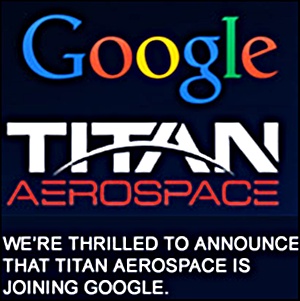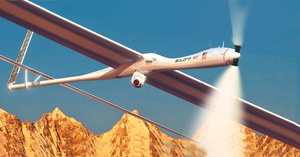Google acquires solar-powered drone maker Titan Aerospace
15 Apr 2014
Google Inc yesterday acquired solar-powered drone maker Titan Aerospace as part of its plans to beam internet from space to two-thirds of the global population that currently has no web access.
 According to a report from technology website TechCrunch last month, Mark Zuckerberg and his group were in discussions with New Mexico-based Titan Aerospace to bring their solar-powered UAVs on board for the ambitious plan of bringing 5 billion people online.
According to a report from technology website TechCrunch last month, Mark Zuckerberg and his group were in discussions with New Mexico-based Titan Aerospace to bring their solar-powered UAVs on board for the ambitious plan of bringing 5 billion people online.
TechCrunch had then put a price tag of around $60 million for the Titan acquisition.
Google did not disclose the financial terms of the deal, but several media reports said that Facebook had earlier held talks to buy Titan, but instead acquired UK-based solar drone maker Ascenta. (See: Facebook aims at internet through UAVs; eyes solar drone maker Titan )
In June 2013, Google had unveiled plans of its top-secret Project Loon, through which balloons carrying internet-beaming antennas would be sent to the edge of space to beam internet to remote areas of the world that currently do not have web access (See: Google reveals plan to beam internet from balloons in stratosphere).
Apart from providing over 4 billion people access to the internet, Project Loon could help during natural disasters, specially when existing communication infrastructure may have been affected.
Founded in 2012, New Mexico-based Titan has 20 employees led by CEO Vern Raburn, who previously founded Eclipse Aviation.
 Titan is developing the Solara 50 and 60 model drones, or ''atmosats'', which can stay in the air for as long as five years and provide high-resolution images, navigation and mapping services, disaster response and voice and data communications.
Titan is developing the Solara 50 and 60 model drones, or ''atmosats'', which can stay in the air for as long as five years and provide high-resolution images, navigation and mapping services, disaster response and voice and data communications.
The dragonfly-shaped Solara drones have a wingspan nearly as large as that of a Boeing 767, and use batteries and solar panels.
The Solara UAVs are said to be capable of night flight powered by internal battery packs and could then use solar power to stay flying for up to five years at an altitude of 20km above sea level, similar to Project Loon.
Titan expects to have a fully developed Solara by 2015.
''It's still early days, but atmospheric satellites could help bring Internet access to millions of people, and help solve other problems, including disaster relief and environmental damage like deforestation,'' Tim Drinan, a spokesman for Google, said in a statement. ''It's why we're so excited to welcome Titan Aerospace to the Google family.''






























